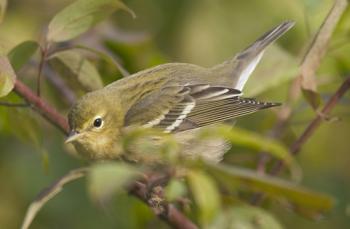
La página que intenta visitar sólo está disponible en inglés. ¡Disculpa!
The page you are about to visit is currently only available in English. Sorry!


Along the south shore of Lake Erie, near my home in northwestern Ohio, the fall migration of warblers has been well under way for the last month. Most of these tiny insect-eaters migrate south early in fall; by the time fall foliage colors are at their peak, most of the warblers are long gone to the south.
To me, the most impressive of all the fall migrant warblers is the Blackpoll Warbler. It's named for the black-capped spring plumage of the adult male; Blackpolls in fall are all dull greenish. But their feats of migration are anything but dull. Blackpoll Warblers nest in the boreal forests of Alaska and Canada (and the extreme northern edge of the Lower 48) and winter mostly in the Amazon Basin of South America. Their spring migration brings them north through the Caribbean and Florida. In fall, though, they move strongly eastward before they head south, some apparently coming all the way across Alaska and Canada to the northeastern coast of the United States. From there, after feeding heavily to take on fuel for their flight, they take off and fly nonstop to the northern coast of South America -- a flight that may cover 2500 miles and take more than three days! Although I've known about this for years it still boggles my mind to think that this little bird, weighing less than an ounce, can undertake such a monumental journey. The Blackpoll Warblers that I've been seeing on the northern edge of Ohio during the last few days may have already come all the way from Alaska, but their major flight is still ahead of them. It's no wonder that the stopover sites along Lake Erie have been designated as Important Bird Areas by Audubon Ohio.